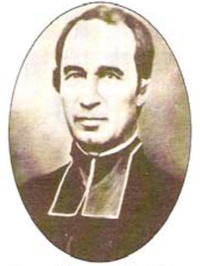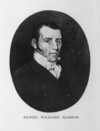
Source: Link
PICARD DESTROISMAISONS, THOMAS-FERRUCE (he signed Thomas Destroismaisons), priest and missionary; b. 12 Jan. 1796 at Saint-Pierre-de-la-Rivière-du-Sud (Saint-Pierre-Montmagny, Que.), son of Philippe Picard Destroismaisons and Rosalie Fournier; d. 5 April 1866 at Saint-François, Île d’Orléans, Canada East.
After completing his secondary education at the Séminaire de Québec, Thomas-Ferruce Picard Destroismaisons was sent to the Collège de Nicolet to teach and to study theology (1816–19). He was ordained priest on 17 Oct. 1819 in the cathedral of Quebec, and went immediately to Saint-Hyacinthe to become curate of the parish of Notre-Dame.
Since 1818 Abbé Joseph-Norbert Provencher*, the first missionary of Red River, had been looking for “a priest and an ecclesiastic” to assist him. Although he did not have all the qualifications required by Provencher – an acquaintance with astronomy, a knowledge of English and of the “Indian tongue,” some skill in construction, and an ability to lead people – Abbé Destroismaisons was chosen by Bishop Joseph-Octave Plessis* to become a missionary in the west. He arrived in Red River on 12 Aug. 1820, four days before Provencher departed for Quebec. Even before his return in August 1822, Provencher was thinking of sending the young missionary back to Lower Canada “when he could be dispensed with,” for he “is not too well liked.” However, Destroismaisons remained and worked with the Indians at the Qu’Appelle River in 1823, at Pembina (North Dakota) in 1824, and at Red River during the summers. Despite great effort, he did not succeed in learning the language of the Indians he visited and had to use an interpreter. During his last years in the west, he was attached principally to the mission of White Horse Plain, of which he was the first officiating priest.
Finally, in 1827, Abbé Destroismaisons was discharged. Despite the partial failure of his missionary career, he was remembered with kindness by Bishop Provencher, who wrote to Bernard-Claude Panet*, bishop of Quebec: “M. Destroismaisons is a good priest full of good will. He will not give any trouble to his bishop.” The civil authorities held him in high esteem; George Simpson*, governor of the Northern Department of the Hudson’s Bay Company, even suggested him as a missionary for the King’s Posts in the east.
In 1827, having returned to Lower Canada, Thomas Destroismaisons became the first parish priest of Saint-Urbain (Saint-Urbain-de-Charlevoix), where he devoted his attention particularly to the building of the church. From 1833 to 1850 he was the parish priest of Saint-Germain (Rimouski), with responsibility for several neighbouring missions. He was occupied with the building of a public hall at Saint-Germain and a church in the mission of Sainte-Luce, demonstrating again his aptitude for construction. These activities, and the great expanse of territory to be ministered to, tired him rapidly, and he wrote: “I did not feel myself endowed with the talents necessary for directing and administering one large parish, or rather several parishes.” From 1848 he exercised his ministry less and less. Notwithstanding his fatigue, he asked to remain at Rimouski, where he felt himself well liked. Abbé Célestin-Zéphirin Rousseau, his curate, willingly conceded the truth of this claim, but considered it a result of the priest’s innocent good nature: “Father Destroismaisons is the best man alive, and towards his parishioners he shows a kindness that is devoid of good sense. To all requests he replies with an interminable succession of yeses, but when it is a question of acting the yeses become ineffective.” Only one group of persons missed this excessive kindness: the Irish orphans. On various occasions two curates reproached the parish priest for ignoring these unfortunate children. The fact seems to be well authenticated, but an explanation is not apparent.
Despite his lack of enthusiasm, Abbé Destroismaisons was finally transferred in 1850 to the small parish of Saint-François, on the Île d’Orléans, where he died in April 1866.
AAQ, 330 CN, I. Archives de l’archevêché de Rimouski (Qué.), 355.106. [J.-N. Provencher], “Lettres de Monseigneur Joseph-Norbert Provencher, premier évêque de Saint-Boniface, Manitoba,” Soc. historique de Saint-Boniface, Bull., III (1913), 5–124. Morice, Hist. de l’Église catholique, I.
© 1976–2024 University of Toronto/Université Laval
Image Gallery

Cite This Article
Nive Voisine, “PICARD DESTROISMAISONS, THOMAS-FERRUCE,” in Dictionary of Canadian Biography, vol. 9, University of Toronto/Université Laval, 2003–, accessed April 23, 2024, http://www.biographi.ca/en/bio/picard_destroismaisons_thomas_ferruce_9E.html.
The citation above shows the format for footnotes and endnotes according to the Chicago manual of style (16th edition). Information to be used in other citation formats:
| Permalink: | http://www.biographi.ca/en/bio/picard_destroismaisons_thomas_ferruce_9E.html |
| Author of Article: | Nive Voisine |
| Title of Article: | PICARD DESTROISMAISONS, THOMAS-FERRUCE |
| Publication Name: | Dictionary of Canadian Biography, vol. 9 |
| Publisher: | University of Toronto/Université Laval |
| Year of publication: | 1976 |
| Year of revision: | 1976 |
| Access Date: | April 23, 2024 |










